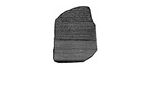User talk:Simon/Technologising the word
traces of book use in from the books
Typologies of traces of use identified from a previous project called From the Books: SLV RBRR 000-099, which explored books from the 000-099 section of the Redmond Barry Reading Room in the State Library of Victoria.
- ACCIDENTAL DOG-EAR
- ANNOTATION
- ASTERISK
- BOOK PRICE
- BOOKMARK
- CIRCLED TEXT
- CREASED PAGE
- CROSS
- DEAD ANT
- DOG-EAR
- ERASER RUBBING
- ERRATA
- FINGERPRINT
- FOLD
- HANDWRITTEN LETTER
- INK BLOT
- LIBRARY DOCUMENT
- LIFTED PRINT
- LINE
- LOOSE PAGE
- NOTEPAPER BOOKMARK
- NOTES
- PAGES REMOVED
- POST-IT NOTE
- RECEIPT BOOKMARK
- REPLACED IMAGE
- SCUFF
- SMUDGE
- SQUIGGLE
- STAIN
- STRIKETHROUGH
- TICK
- TORN PAGE
- TORN PAPER BOOKMARK
- UNDERLINING
- WARPED PAGE
- WEAR AND TEAR
These formed a loose classification system that indexed these books not by bibliographic reference, but by the frequency of occurrence, taking a "bag of words" approach. Problems that arose were linguistic - it was difficult assigning a word to an example as this already had some assumption of intention (e.g. a doodle as an intentional drawing vs squiggle as unintentional drawing).
thoughts and reflections
My approach was one of identification based on nouns, which presented problems in describing the traces we found and the possible intention (or lack of intention) in their making. To what extent could the noun communicate what had happened? Nouns point towards things affected by actions. In a sense, to name something is to own it, and things become property much more easily than actions.

